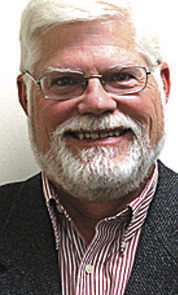Ink Spo ts
Matt Paxton
After a four-year, $161 million renovation, the University of Virginia’s main library reopened in January, and it was announced a couple of weeks ago that it is being renamed for the university’s fourth president, Edgar F. Shannon. The library was previously named for the university’s first president, Edwin Alderman.
Why would this bit of news be the subject of my column? Because Edgar Shannon was a Lexington native. His father was a professor at Washington and Lee University, and Shannon graduated from W&L. He was a Rhodes Scholar and received his doctorate from Oxford in 1949.
After Pearl Harbor, Shannon volunteered for the U.S. Navy, serving as a junior officer on the cruiser USS Quincy. The Quincy and three other American ships were sunk the night of Aug. 8, 1942, off Guadalcanal. Three hundred seventy sailors died, including the captain. Shannon was wounded but survived a 20-hour ordeal in the water. He served though the war and was awarded a Bronze Star and 10 battle stars.
After the war, he taught at Harvard for several years, then went to England on Fulbright and Guggenheim fellowships, where he developed an interest in the poet Alfred, Lord Tennyson. He joined the faculty of the University of Virginia in 1956.
In 1959, he was named president of the university, and began to change the then 140-year-old institution. He pushed for greater integration of Black students and women, and oversaw the co-education of the undergraduate College of Arts and Sciences in the early 1970s. During Shannon’s tenure, the enrollment rose from 5,000 students in 1959 to 15,000 when he stepped down in 1974.
Shannon was also greatly responsible for enhancing the academic reputation of the school. Former UVa President John Casteen said of Shannon, “He drove the university toward academic excellence, which had not been a major consideration previously.”
In the spring of 1970, after the invasion of Cambodia and the killings at Kent State University, UVa students boycotted classes, occupied the ROTC building and blocked traffic. Shannon spoke to a crowd of 4,000 student protestors from the steps of the Rotunda. Initially, he was booed but was cheered when he told the crowd that he agreed with their opposition to the war, and signed telegrams addressed to Virginia’s senators urging an end to the fighting.
Later, Shannon was criticized by some university alumni, and a few newspapers in the area called for his dismissal. But the university’s board supported him, noting that he had kept the university open and free of violence when many other colleges and universities were forced to send students home. When he spoke at commencement several weeks after the protests, he was given a standing ovation.
He was the president when I entered UVa in 1972. I remember Dr. Shannon as being very approachable. The president always had a reception for first-year students at Carr’s Hill, the president’s house, and I remember he asked about Lexington and about my family when I introduced myself.
The transformation of the University of Virginia from a provincial, male, white, Southern college into one of the top public universities in America began during Edgar Shannon’s presidency. We should be proud that a “local boy” did so well. It’s fitting that the library at UVa will bear his name.

.jpg)


